Physical Address
304 North Cardinal St.
Dorchester Center, MA 02124
Antineutrophil cytoplasmic antibody (ANCA)-associated vasculitis (AAV) is a group of vasculitides characterized by small- to medium-sized blood vessel inflammation, clinically overlapping features, and the presence of ANCA. This group comprises granulomatosis with polyangiitis (GPA), formerly Wegener granulomatosis; microscopic polyangiitis (MPA); eosinophilic granulomatosis with polyangiitis (EGPA), formerly Churg–Strauss syndrome; and renal-limited pauci-immune glomerulonephritis. These conditions are rare in childhood and adolescence. Consequently, most knowledge about them comes from small case series or studies of adults. Early diagnosis and treatment are critical to minimizing morbidity and improving outcomes in these patients.
The identification of the clinical and pathogenic significance of ANCAs has led to subclassification of small-vessel vasculitis under the rubric of AAV. ANCAs are a heterogeneous group of autoantibodies that bind to antigens in the primary granules of neutrophils and the lysosomes of monocytes. ANCAs are detected by immunofluorescence microscopy in cytoplasmic (cANCA), perinuclear (pANCA), indeterminate, or atypical patterns ( Fig. 36.1 ). The predominant target antigens of cANCA and pANCA, respectively, are proteinase 3 (PR3) and myeloperoxidase (MPO). Antibodies to targets PR3 and MPO, respectively called PR3-ANCA or MPO-ANCA, are found in AAV, renal-limited vasculitis, and certain drug-induced vasculitis syndromes. , The presence of either has been used in classification algorithms to distinguish GPA and MPA from polyarteritis nodosa (PAN), , but the different specificities of ANCA do not clearly differentiate among AAV. PR3-ANCA (cANCA) is highly associated with GPA, , although it should be noted that nearly 50% of patients with localized forms of GPA are ANCA negative. It is also found in up to 30% of patients with MPA and less than 5% of patients with EGPA. MPO-ANCA is found in up to 70% of patients with MPA but may also be found in about 10% of patients with GPA. , ANCA, predominantly MPO-ANCA, is found in up to 40% of patients with EGPA. ,
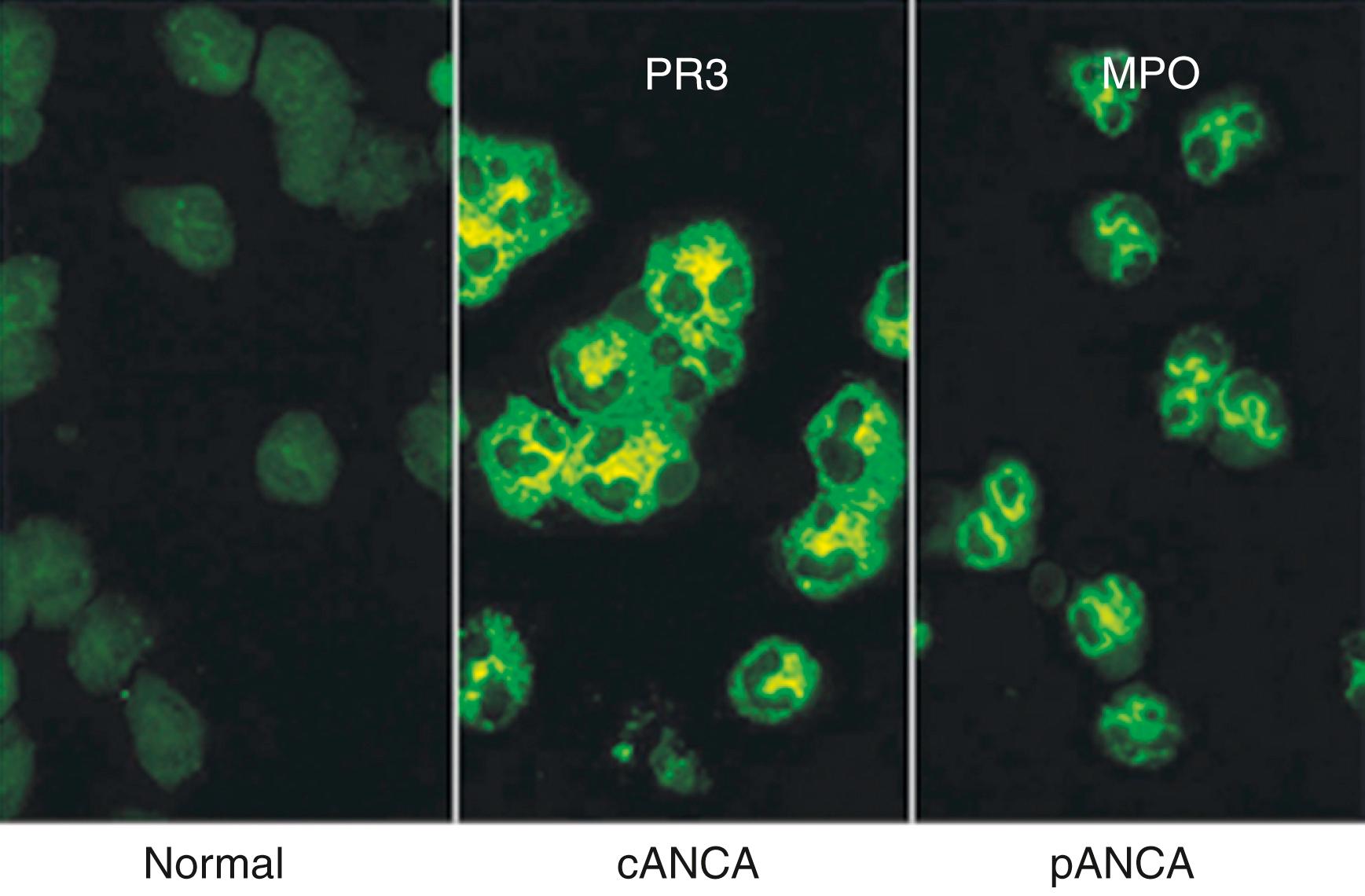
Genome wide studies suggest that GPA and MPA are genetically distinct subsets of AAV. However, the associations with identified single nucleotide polymorphisms (SNPs) were stronger with “PR3-ANCA versus MPO-ANCA” rather than the traditional “GPA versus MPA” phenotype. Supporting this notion are clinical studies showing that ANCA serotype, or ANCA serotype linked with specific organ involvement, is more relevant prognostically than traditional GPA or MPA phenotypes. Another study suggests that among AAV patients with pulmonary involvement, ANCA specificity may associate with different imaging patterns of lung involvement. Even if these findings are confirmed, classifying patients according to ANCA serotype alone would leave many small-vessel vasculitis ANCA-negative patients unclassifiable. The role of ANCA in the pathogenesis of AAV needs to account for ANCA-negative patients and the lack of association of disease activity with ANCA titers in some studies.
ANCAs may be naturally occurring nonpathogenic autoantibodies , that become pathogenic because of defects in regulatory T cells, or their induction may relate to molecular mimicry or epigenetic modifications of target antigens. Mechanistically, in vitro experiments demonstrate that ANCA-activated neutrophils can in themselves cause endothelial damage , and can also cause a cascade of other detrimental inflammatory processes. In vivo studies in mice and rats demonstrate the pathogenic potential of MPO-ANCA for development of crescentic glomerulonephritis, pulmonary capillaritis, and systemic necrotizing vasculitis. Three individual case reports describe transplacental transfer of MPO-ANCA from mother to newborn, causing neonatal MPA in two of the infants , and no disease in the third. Arguments for a primary pathogenic role of autoantibodies are the success in studies of B-cell depletion therapy with rituximab, and also the observation that activated B lymphocytes are increased in patients with active GPA compared with those in remission and healthy controls. The overlapping clinical features of MPA with GPA and EGPA likely reflect the small-vessel vasculitis component of the diseases, whereas the differences reflect the presence of an additional granulomatous inflammatory process in GPA, and eosinophilia plus granulomatous inflammation in EGPA. , Herein is part of the difficulty in attempts to successfully develop a robust PR3-ANCA vasculitis animal model similar to the MPO-ANCA animal models. ,
GPA is a chronic vasculitis involving small- to medium-sized vessels. It is characterized by granulomatous inflammation of the upper and lower respiratory tracts; necrotizing, pauci-immune glomerulonephritis; and vasculitis that frequently involves other organs. McBride first described the condition in 1897 as a midfacial granuloma syndrome, but the wider spectrum of organ involvement and disease severity was not described until the 1930s. , GPA, previously known as Wegener granulomatosis, was renamed in 2011 with a consensus recommendation of the American College of Rheumatology (ACR), the American Society of Nephrology, and the European League Against Rheumatism (EULAR). Although GPA is most common in later life, and rare in childhood, it may be one of the most common forms of chronic vasculitis seen by pediatric rheumatologists.
The ACR classification criteria for GPA, derived primarily from adult data, performed poorly in classifying childhood GPA. Consequently, a pediatric-specific adaptation of ACR criteria, the EULAR/Pediatric Rheumatology International Trials Organization (PRINTO)/Pediatric Rheumatology European Society (PReS) criteria, were developed using pediatric data (see Chapter 32 ). The EULAR/PRINTO/PReS criteria, which incorporates laryngotracheal stenosis and the presence of ANCA as individual criteria, are compared with the ACR criteria in Table 36.1 . The EULAR/PRINTO/PReS criteria for GPA had improved sensitivity compared with the ACR criteria (93% vs. 83%) in the validation cohort that included a wide spectrum of vasculitides. The sensitivities of both criteria were much reduced (77% and 62%, respectively) when applied to a cohort of 155 pediatric patients that included only those with AAV and unclassified vasculitis. This discrepancy likely reflects the absence of criteria for MPA in both classification systems, and the inability of GPA criteria to discriminate MPA patients among a cohort that did not include patients with large-vessel vasculitis. In one report, many pediatric patients classified as having GPA according to ACR criteria could be described as having MPA according to the International Chapel Hill Consensus Conference (CHCC) disease definitions.
| ACR CRITERIA | EULAR/PRINTO/PRES CRITERIA |
|---|---|
| A patient is said to have GPA when two of the following four criteria are present: | A patient is said to have GPA when three of the following six criteria are present: |
| Descriptors | Descriptors | |||
|---|---|---|---|---|
| 1 |
|
|
|
Nasal septal perforation or saddle-nose deformity |
| 2 |
chest X-ray |
|
|
|
| 3 |
|
Microhematuria: >5 RBC/high-power field |
|
Hematuria or red blood cell casts: >5 red blood cells per high-power field, or red blood cell casts in urinary sediment, or >2+ on dipstick |
| 4 |
|
|
|
|
| 5 |
|
|
||
| 6 |
|
|
||
Population studies in adults estimate an overall annual incidence range between 0.5 and 20 cases per 1 million persons and a prevalence of 20 to 160 cases per 1 million persons. , A recent study from the United States using an administrative claims database reported an incidence rate of 12.8 cases per 1 million person-years. Regional differences of GPA have been described with higher incidences in both Norway and areas of the United Kingdom compared with Spain and Japan. , A study in New Zealand similarly describes a higher incidence in higher latitudes. A cyclical pattern of occurrence of GPA has also been noted. ,
Less is known about the incidence of GPA in children and adolescents. Reported incidence rates of GPA from the US administrative database study and a Swedish regional study were, respectively, 1.8 and 1.4 cases per 1 million children. A Canadian study reported an average incidence rate of 0.9 per million children per year from 1994 to 2003, increasing to 6.4 cases per million per year from 2004 to 2008 in Southern Alberta. A recent French study also reported an increasing annual incidence of combined AAV from 0.10 per million children in 1986 to 1990 to 0.45 per million children in 2006 to 2010.
In the general population, the peak incidence of GPA is in the sixth decade, , and men outnumber women 1.6:1 to1:1. , In the pediatric population, the disease occurs in the second decade of life, with a female preponderance.
The cause of GPA is unknown, although it is likely a multifactorial disease. , As with many other polygenic systemic autoimmune diseases, GPA is probably the result of interactions between genetic factors predisposing to loss of self-tolerance and triggering environmental exposures. Recent data from genome-wide association studies (GWAS) provide strong support for the genetic role in the etiology of AAV. , , The strongest associations are with major histocompatibility complex (MHC) class II genes, and specifically in GPA, with the HLA-DP region. , Non-MHC genes identified as associated with AAV include PTPN22 (encoding protein tyrosine phosphatase nonreceptor type 22), SERPINA1 (encoding α1-antitrypsin), PRTN3 (encoding PR3), and SEMA6A (encoding semaphorin 6a).
Environmental factors that have been implicated as triggers for the development of GPA include infections ( Staphylococcus aureus , and other respiratory tract infections), drugs (including propylthiouracil, hydralazine, and minocycline), , and silica dust. ,
Triggering factors along with genetic predisposition and immune dysregulation , may establish a cascade that includes release of proinflammatory cytokines, release and translocation of ANCA antigens to the cell surface, and priming of neutrophils. Primed neutrophils activated by ANCA are key effector cells of endothelial injury, including through release of neutrophil extracellular traps and mediation of complement activation. The alternative complement pathway is also involved in an inflammatory amplification loop. Although autoantibodies probably play a key role in GPA pathogenesis, the characteristic presence of granulomas suggests a more complex process with involvement of cellular immunity and cell-mediated hypersensitivity. Elucidation of the intricate immune pathways and processes is ongoing.
The triad of upper and lower respiratory tract inflammation and renal disease is characteristic of childhood GPA. , , The largest cohort describes 183 patients collected within A Registry for Children with Vasculitis (ARChiVe) and includes patients accumulated since the earlier report of 65 patients. The median age at diagnosis was 14 years (range 2 to 18) and the median interval from symptom onset to diagnosis was 2.1 months (range 0 to 73). At disease onset, the most common features were constitutional symptoms followed by renal (83%); pulmonary (74%); and ear, nose, and throat (ENT) (70%) manifestations. Less frequently involved were the musculoskeletal system (65%), skin (47%), eyes (43%), gastrointestinal tract (36%), and nervous system (20%). A list of clinical features according to organ system and their frequencies is shown in Table 36.2 . These findings were similar to those of the next largest pediatric GPA cohort described by Bohm et al., except the ARChiVe cohort had higher frequencies of renal (83% vs. 68%) and gastrointestinal involvement (36% vs. 16%) and lower frequency of ENT involvement (70% vs. 91%). Clinical features in the largest cohort of pediatric patients with MPA are listed for comparison. In contrast to the adult experience , and two smaller pediatric series, , so-called limited or localized GPA, defined by the absence of kidney disease, occurred in a minority of children at the time of diagnosis. , The spectrum of pulmonary manifestations in the ARChiVe cohort included chronic cough (54%), hemoptysis or alveolar hemorrhage (42%), and respiratory failure (12%). Although upper and lower respiratory tract features were similarly frequent at disease presentation in studies with follow-up, upper respiratory tract features accumulated and were reported in 91% and 96% of patients. , One study reported that subglottic stenosis was five times as common in pediatric-onset GPA compared with adults, and this feature was subsequently included in the EULAR/PReS classification criteria. In the ARChiVe cohort, subglottic stenosis occurring in 10% was no more frequent than otitis/mastoiditis or hearing loss, less frequent than nasal and sinus involvement, and no more frequent than in adult studies. , , Its inclusion as a pediatric classification criterion reflected its specificity in children rather than an increased frequency. In a cohort of 28 patients from the Cleveland Clinic, a quaternary referral center for vasculitis, airway stenosis with careful screening at diagnosis occurred in 36% of children, increasing to 50% at follow-up; among the 14 patients with airway stenosis, the tracheobronchial tree was involved in five. Damage to the nasal cartilage, characteristic of long-standing disease, may result in a saddle-nose deformity, similar to that seen in relapsing polychondritis ( Fig. 36.2 ).
| Clinical Feature | GPA (n = 183) | MPA (n = 48) |
|---|---|---|
| Constitutional/General | 88 | 85 |
|
83 | 77 |
|
53 | 52 |
|
44 | 31 |
| Renal | 83 | 75 |
|
72 | 69 |
|
72 | 60 |
glomerulonephritis |
94 (101 of 108) |
94 (30 of 32) |
|
54 | 58 |
| Pulmonary | 74 | 44 |
|
42 | 15 |
|
54 | 0 |
|
36 | 0 |
|
22 | 13 |
|
14 | 8 |
|
12 | 4 |
| Ear, Nose, Throat | 70 | 4 |
|
53 | 0 |
|
39 | 0 |
|
17 | 0 |
|
10 | 0 |
|
10 | 0 |
|
15 | 4 |
| Musculoskeletal | 65 | 52 |
|
61 ∗ | 42 |
myositis |
14 | 19 |
| Cutaneous | 47 | 52 |
|
27 | 31 |
| Eyes | 43 | 31 |
|
10 | 2 |
|
11 | 6 |
|
8 | 4 |
| Gastrointestinal | 36 | 58 |
|
22 | 38 |
|
12 | 33 |
| Nervous System | 20 | 21 |
|
11 | 13 |
|
7 | 4 |
| Cardiovascular | 5 | 6 |
∗ Arthralgias and arthritis at disease onset were not reported separately.
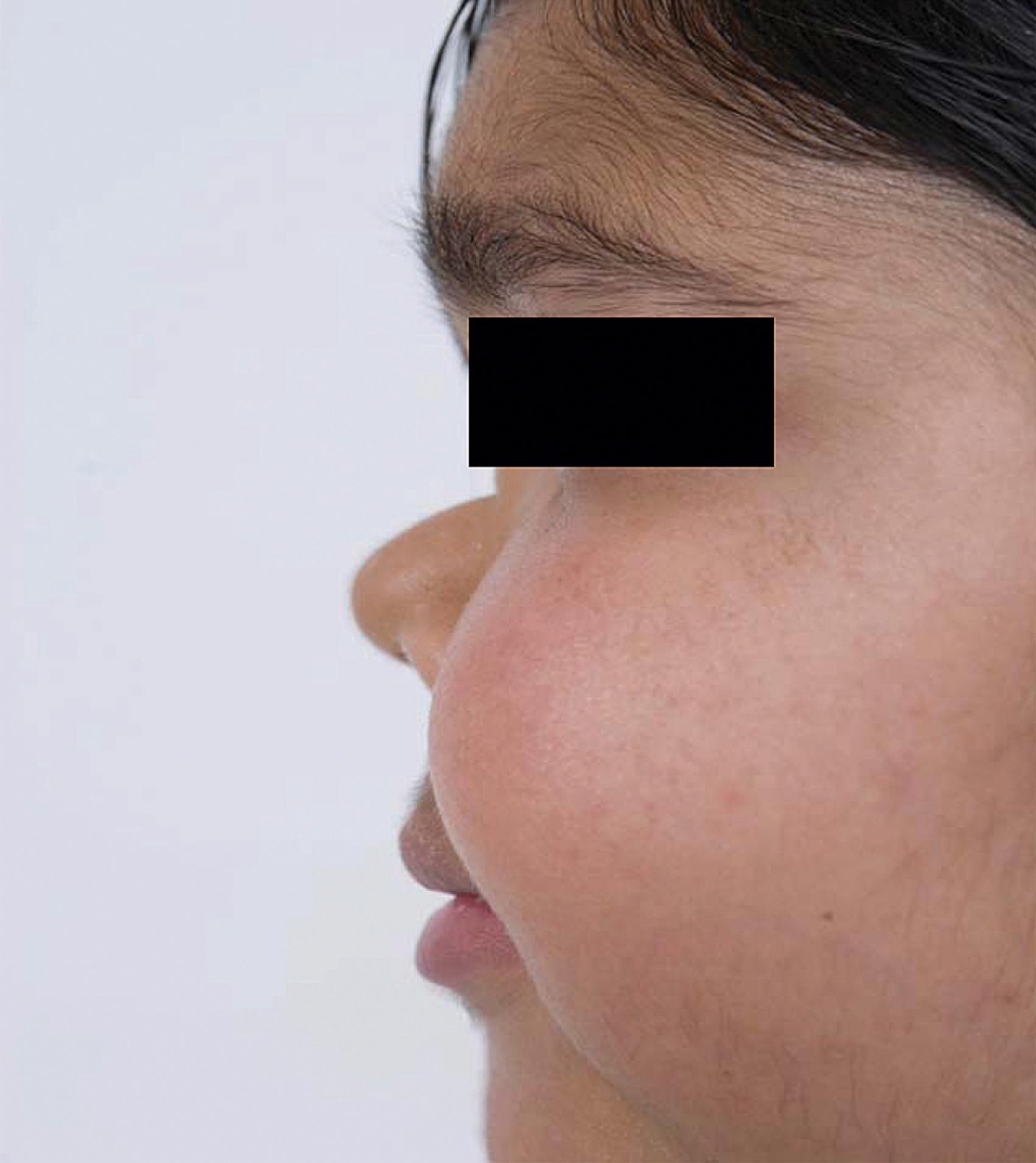
The diagnosis of GPA is based on a combination of clinical features, the presence of serological markers (specifically ANCA and, most commonly, PR3-ANCA or cANCA), and characteristic histopathological findings (inflammation of predominantly small to medium arteries, capillaries or small veins, or pauci-immune glomerulonephritis). The presence of pulmonary hemorrhage and glomerulonephritis (i.e., pulmonary-renal syndrome) is a classic presentation of GPA, and the diagnosis should be considered in any patient who presents with this type of organ involvement. If GPA is suspected, it is important to take a careful and specific history of upper respiratory tract involvement and consider formal otolaryngological assessment. Because one-third of adult patients initially have asymptomatic renal and pulmonary involvement, it is crucial to examine fresh-spun urinary sediment and look for pulmonary changes both radiographically and with pulmonary function testing. An increase in the diffusion capacity of carbon monoxide (DL CO ) may be the earliest sign of pulmonary hemorrhage. If the disease is limited to a single organ system , tissue diagnosis is desirable to confirm the diagnosis and exclude other diseases. The differential diagnoses include infections (notably mycobacteria, fungi, or helminths, which may also be associated with granulomatous vasculitis), neoplastic disease, sarcoidosis, immunoglobulin (Ig)G4-related disease, and in young children, chronic granulomatous disease. Pulmonary manifestations in ANCA-positive ulcerative colitis patients have also mimicked GPA. Other diseases that can manifest as pulmonary-renal syndromes, such as antiglomerular basement membrane (anti-GBM) disease, systemic lupus erythematosus, mixed connective tissue disease, or IgA vasculitis, should also be considered. Guided kidney biopsy is a relatively safe procedure with a high yield, and the finding of pauci-immune glomerulonephritis together with characteristic serology provides a relatively secure diagnosis. GPA can be more readily distinguished from MPA by the presence of upper airway disease including saddle-nose deformity, nasal septal perforation, subglottic stenosis, dacryocystitis, proptosis associated with periorbital tumor, characteristic lung nodules (distinguished from hemorrhage), or the presence of granuloma in biopsy specimens. Characteristic histological features may be patchy in the lungs, and the yield from biopsies may be low, especially with fine-needle aspirations, but are better with transbronchial or open lung procedures. , Upper respiratory tract involvement in patients with GPA (e.g., trachea, ears, nose, sinuses, and eyes) may offer sites for relatively noninvasive biopsy procedures; however, the yield from such sites is disappointingly low. When the disease is isolated to these sites, a definitive diagnosis may be difficult, and the clinician may need to rely on nonspecific or incomplete histopathological confirmation, serological findings, and the combined expertise of multiple disciplines, including the otorhinolaryngologist, ophthalmologist, pathologist, radiologist, and rheumatologist. The need for tissue diagnosis in such cases may be influenced by disease severity, the need to embark upon aggressive therapies such as cyclophosphamide, and the need to exclude other diseases.
White blood cell counts may be elevated particularly in active generalized disease, and associated with normochromic normocytic anemia, thrombocytosis, and markedly elevated erythrocyte sedimentation rates (ESRs) or C-reactive protein levels. , In early or localized disease, these tests may be normal or only slightly abnormal. Standard clinical laboratory measures of inflammation (e.g., for guiding therapy withdrawal) are often not useful in distinguishing inactive disease from low levels of inflammation. Among other more commonly used and available inflammatory measures, S100 calcium-binding protein A12 (S100A12) serum levels and neutrophil counts track inflammation best among children with PR3-ANCA disease, and similarly for adult patients, serum calprotectin (S100A8/A9) may have a role. von Willebrand factor antigen (vWFAg), a nonspecific marker of endothelial injury, has been shown to be elevated in other forms of vasculitis during active disease and may be elevated in AAV. Other potential biomarkers of vascular inflammation and injury include matrix metalloproteinase-3 (MMP-3), tissue inhibitor of MMP-1, pentraxin3 (PTX3), and B-cell attracting chemokine 1 (CXCL13).
Proteinuria, microscopic hematuria, and red blood cell casts in a fresh urine sample indicate active glomerular disease. , Gross hematuria is uncommon. Persistent elevation of blood urea nitrogen and serum creatinine levels indicates the presence of significant renal disease. A search for other urinary biomarkers of disease activity or relapse continues.
Antinuclear antibodies are present in up to one-third of children tested. , Rheumatoid factor is present in approximately 50% of adult and pediatric patients. , Children with GPA may be at risk for thrombosis because of antiphospholipid antibodies and factor V Leiden mutations. Antiphospholipid antibodies were evident at presentation in six (18%) of 34 children tested in one series but were not associated with venous thrombosis. The antibodies were present in two of nine children in another series who had venous thrombosis.
In a cohort of 183 children with GPA, ANCAs of any kind (cANCA, pANCA, PR3-ANCA, or MPO-ANCA) were present in 95% of 181 children who were tested. Either cANCA or PR3-ANCA was present in 67%, and either pANCA or MPO-ANCA was present in 26%. Similar frequencies of ANCA positivity were found in other pediatric series , and in adult series. , The clinical utility of serial ANCA measurements to predict relapse in adults remains controversial, and at best there may be a role for tracking PR3-ANCA in very limited circumstances depending on disease phenotype and treatment choice.
The full histological spectrum of GPA includes necrotizing granulomas of the upper and/or lower respiratory tract, with necrotizing or granulomatous vasculitis involving predominantly small arteries and veins (commonly in the lungs but also in other organs) and focal segmental necrotizing glomerulonephritis. Granulomata characterize the disease and show acute and chronic inflammation with central necrosis and histiocytes, lymphocytes, and giant cells; eosinophils may be present in small numbers, which should not be confused with the large numbers found in specimens from EGPA patients ( Fig. 36.3 ). Renal glomeruli are infiltrated with lymphocytes and histiocytes. The earliest renal change may be glomerular thrombosis, but the most commonly reported renal lesions are extracapillary proliferation (with or without fibrinoid necrosis) and crescent formation found in a focal and segmental pattern, followed by necrotizing glomerulonephritis. Renal granulomata are rare. Immunofluorescence microscopy is characteristic of a pauci-immune pattern with scanty deposition of Ig and complement. Dense subendothelial deposits are visible on electron microscopy.
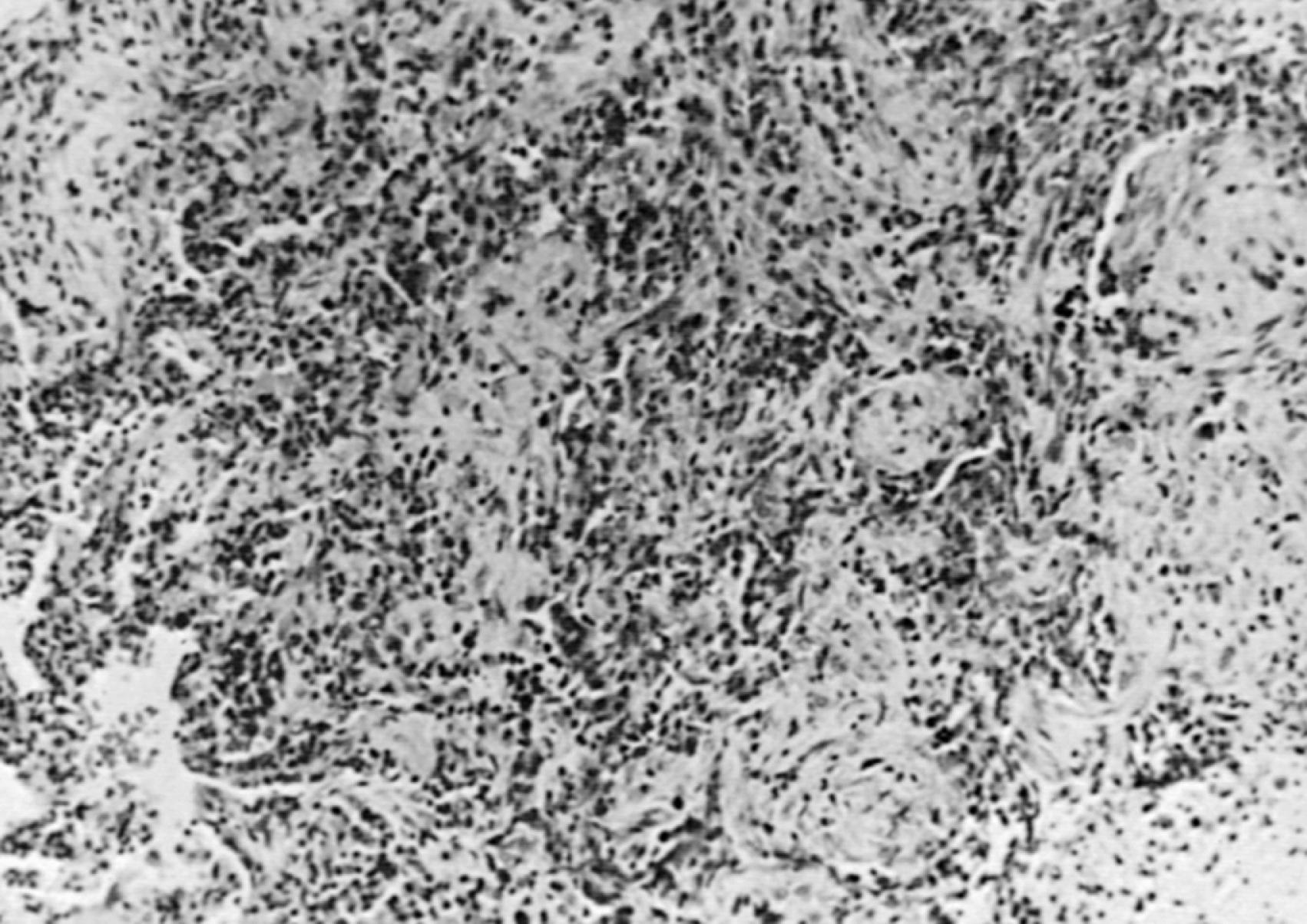
The majority of children with GPA have abnormalities on chest radiographs, with both nodules and fixed infiltrates occurring in one-third to half of patients ( Fig. 36.4 ). Cavitations, pleural effusions, and pneumothoraces may also occur. Although these gross abnormalities are readily detectable on conventional radiography, , high-resolution computed tomography (HRCT) is more effective at detecting other characteristic changes such as small nodules; linear opacities; focal low attenuation infiltrates , ; centrilobular, perivascular densities ; and the computed tomography (CT) “halo” sign associated with hemorrhage ( Fig. 36.5 ). Sinus radiographs or CT scans may demonstrate thickening of the sinus lining, opacification of the frontal or maxillary sinuses, or bony thickening, cavitation, and destruction ( Fig. 36.6 ). However, magnetic resonance imaging (MRI) is superior in defining highly active mucosal disease. MRI is also helpful in visualizing soft tissue changes that involve the nose, orbits, mastoids, and upper airways (i.e., subglottic stenosis). The 18 F-fluorodeoxyglucose positron emission tomography (PET)/CT scan may also be useful in GPA, especially for delineating disease distribution and guiding biopsies of active lesions.
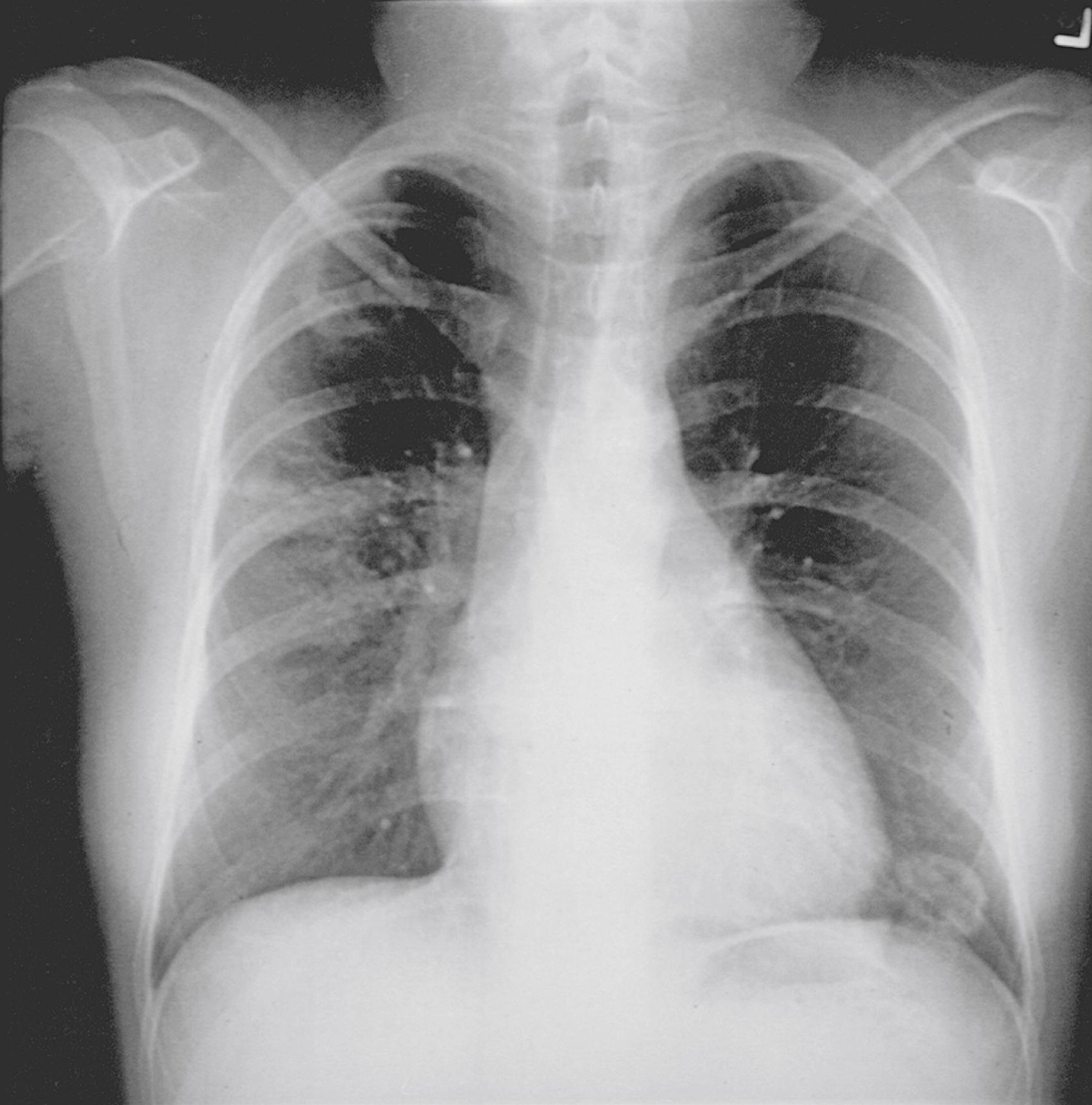
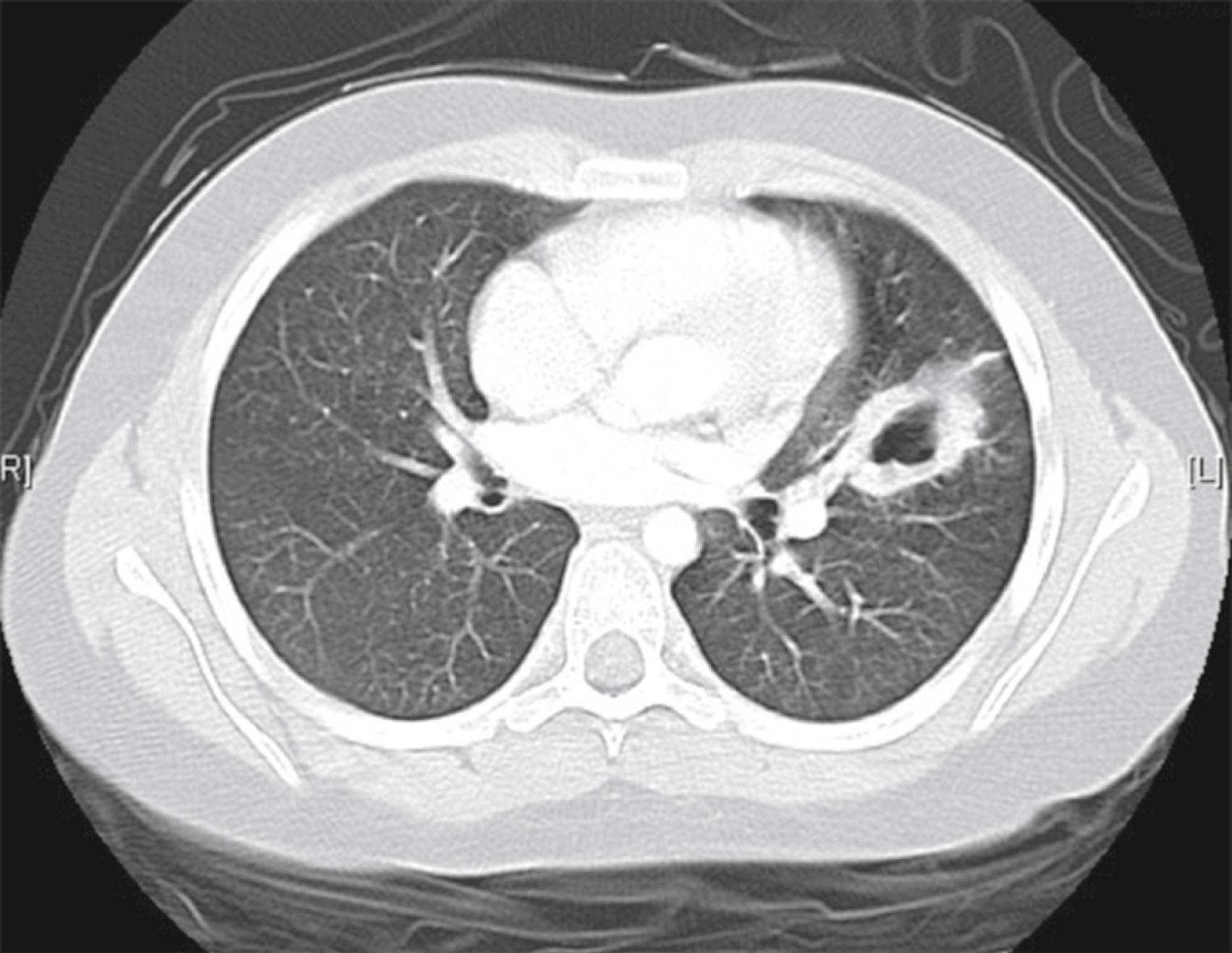
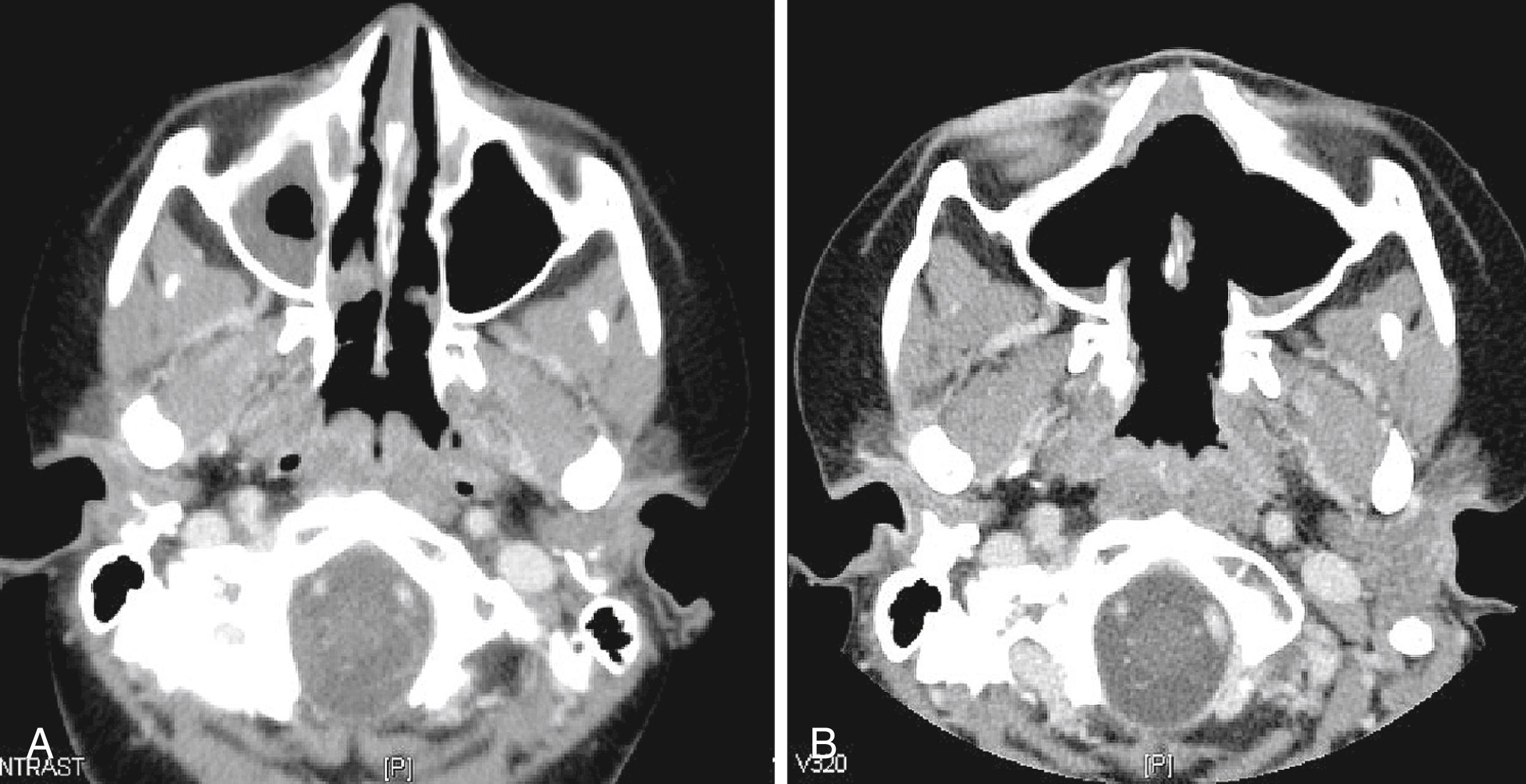
Although previously fatal in most patients, , the aggressive and prolonged use of corticosteroids and cyclophosphamide (CYC) induced remission in more than 90% of adult , and pediatric patients. Although they are lifesaving, , disease relapses were frequent, and CYC-related toxicity (infections, bone marrow failure, infertility, hemorrhagic cystitis, and bladder cancer) was high. , , , Current management of patients with GPA remains challenging because of the chronic relapsing course and the need to balance risks of acute accumulating disease burden against short- and long-term treatment risks, , while avoiding undertreatment of aggressive disease or overtreatment of milder disease. In general, current recommendations are that more toxic treatments such as CYC and high-dose corticosteroids should be used for patients defined as having more severe disease ( Table 36.3 ), , and the duration of these treatments should be limited to a relatively short period (3 to 6 months) of remission induction followed by a longer remission maintenance period (2 to 4 years) of less intensive immune suppression. , , The following sections, Tables 36.4 and 36.5 , and a recent review summarize the conclusions from several clinical trials in adults. It should be noted that the majority of trials have included both GPA and MPA patients, but not patients with EGPA, under the collective rubric of AAV. There have been no trials in children; however, three ongoing trials have included children.
| European Vasculitis Network (Euvas) Scheme | |
|---|---|
| Subgroup | Organ Involvement |
| Localized | Confined to upper and/or lower respiratory tract |
| Early systemic | Any organ system except renal, and no imminent vital organ failure |
| Generalized | Renal with serum creatinine level <500 μmol/L and/or other imminent vital organ failure |
| Severe renal | Renal with serum creatinine level >500 μmol/L |
| Refractory | Progressive disease despite standard therapy with glucocorticoids and cyclophosphamide |
| Vasculitis Clinical Research Consortium (Vcrc) Scheme | |
|---|---|
| Subgroup | Definition |
| Limited | No red blood cell casts in urine If hematuria is present, serum creatinine is ≤1.4 mg/dL, and creatinine rise is no greater than 25% above baseline If pulmonary involvement, PO 2 in room air >70 mm Hg and O 2 saturation >92% Pulmonary hemorrhage may be included provided there is no evidence of progression No other critical organ involvement requiring immediate institution of maximal therapy |
| Severe | Any patient whose disease is not classifiable as limited |
| Trial | Type of Patients (Stage) | Treatment | Conclusion |
|---|---|---|---|
| NORAM | GPA or MPA (early systemic) |
MTX versus oral daily CYC | MTX not inferior to CYC for remission induction |
| CYCLOPS | GPA or MPA (generalized) |
IV pulse CYC versus oral daily CYC | IV pulse CYC not inferior to oral CYC for remission induction, higher relapse rates with IV pulse CYC |
| RAVE | GPA or MPA (generalized) |
RTX versus oral daily CYC | RTX not inferior to CYC for remission induction; RTX better than CYC for relapsing disease |
| RITUXVAS | AAV with renal disease (generalized) |
RTX versus IV pulse CYC | RTX not inferior to CYC for remission induction |
| MEPEX , | AAV with severe renal disease (severe) |
Plasma exchange versus IV pulse methylprednisolone (3 doses); both groups received oral daily CYC | Early renal outcomes better in plasma exchange group but rates of ESRD, mortality, and relapse were similar at 4-year follow-up |
| Plasma exchange for remission induction in GPA | GPA with moderate to severe renal disease (generalized and severe) |
Plasma exchange plus standard immunosuppression versus standard immunosuppression | Improved renal survival in plasma exchange group, no difference in mortality rates |
| MYCYC | GPA and MPA (generalized) |
MMF versus IV CYC | MMF was noninferior to CYC for remission induction, but resulted in higher relapse rates |
| PEXIVAS | AAV (severe) |
Plasma exchange versus no plasma exchange (both groups receive CYC or rituximab), two glucocorticoid regimens | Plasma exchange does not reduce the risk of ESRD or death in patients with ANCA-associated vasculitis |
| Trial | Type of Patients | Treatment | Conclusion |
|---|---|---|---|
| CYCAZAREM | GPA or MPA (generalized) |
AZA versus oral daily CYC | No difference in relapse rates |
| IMPROVE | GPA or MPA (generalized) |
MMF versus AZA | More relapses with MMF |
| WEGENT | GPA or MPA (generalized) |
MTX versus AZA | Similar adverse event rate and relapse rates |
| LEM | GPA (generalized) |
MTX versus leflunomide | Study terminated due to higher than expected relapse rates in MTX group; trend toward more adverse events in leflunomide group |
| WGET | GPA (limited or severe) |
Etanercept plus standard therapy versus placebo plus standard therapy (CYC or MTX) | Etanercept is not effective for remission maintenance and high rate of complications including cancers in the etanercept group |
| REMAIN | GPA or MPA (generalized) |
AZA for 18–24 months versus 4 years following remission induction | Remission maintenance with AZA beyond 24 months after diagnosis reduces relapse risk out to 48 months and improves renal survival in AAV |
| MAINRITSAN | GPA or MPA (generalized) |
RTX versus AZA for remission maintenance | RTX for maintenance is superior to AZA at preventing major relapses at 28 months |
EULAR, the European Renal Association-European Dialysis and Transplant Association (ERA-EDTA), and the Canadian Vasculitis research network (CanVasc) have published guidelines for the management of AAV in adults. , In the absence of pediatric recommendations, these guidelines have also been extrapolated to children; however, in 2018 the first set of pediatric-specific recommendations were published by the Single Hub and Access point for pediatric Rheumatology in Europe (SHARE) initiative, and these represent an important step forward in the management of pediatric AAV.
Glucocorticoids remain a cornerstone of therapy for remission induction and maintenance of remission, but they also carry a toxicity burden well recognized in adult patients. In critically ill patients, high-dose intravenous methylprednisolone can be used initially. Otherwise, for remission induction, prednisone should be started at a dose of 1 to 2 mg/kg/day to a maximum of 60 mg in two divided doses to be given for 2 to 4 weeks before switching to single daily dose and a weaning schedule ( Table 36.6 ). Tapering by 10% to 20% each month should occur as long as the patient remains well with no evidence of worsening disease activity. A target dose of 0.2 mg/kg/day (or 10 mg/day, whichever is lowest) by month 6 should be the goal with ongoing low “maintenance” doses up to month 12.
| Phase | Drug | Regimen |
|---|---|---|
| Induction (3–6 months) |
Prednisone PLUS |
1–2 mg/kg/day PO in two divided doses (max, 60 mg); exceptionally ill patients initially receive methylprednisolone, 30 mg/kg/day (max, 1 g) for 1–3 days IV |
| Cyclophosphamide OR |
15 mg/kg IV every 2 weeks for three doses and then three weekly ( alternatively, 0.5–1.0 g/m 2 monthly IV pulses after NIH SLE protocol ) (max IV dose 1200 mg) or 2 mg/kg/day PO For selected patients, rituximab may be considered as an alternative, adjunctive plasmapheresis may also be considered |
|
| Methotrexate | 0.5–1 mg/kg SC once weekly (max, 25–30 mg) (early systemic/localized disease without renal disease) |
|
| Maintenance (minimum 18–24 months) |
Prednisone PLUS |
After 4 weeks, prednisone is consolidated and tapered as long as the patient remains well |
| Methotrexate OR |
0.5–1 mg/kg SC once weekly (max, 25–30 mg) | |
| Azathioprine OR |
2 mg/kg/day PO | |
| Rituximab | 500 –750 mg/m 2 /dose (max, 1 g per dose) once every 6 months | |
| Refractory | Rituximab | 375 mg/m 2 /week for 4 weeks (alternatively 500–750 mg/m 2 /dose 2 weeks apart for two doses [max, 1 g per dose] is also being used) |
| Intravenous immunoglobulin Mycophenolate mofetil |
2 g/kg monthly 300–600 mg/m 2 /dose twice daily (max, 3 g/day) |
Administering CYC for 3 to 6 months until remission is achieved, and then switching to less aggressive therapy for remission maintenance, has been the predominant strategy used to reduce CYC burden. The European Vasculitis Study Group (EUVAS) designed and tested a regimen to administer the CYC by intermittent intravenous pulses (see Table 36.6 ) as an alternative to oral induction therapy that uses 30% to 50% less CYC. , The results of using CYC according to the EUVAS protocol were not inferior to daily oral therapy at inducing remission; however, intravenous treatment was associated with a higher rate of relapse in the long term but lower rates of leukopenia and infection. , Of note, for patients who fail to achieve remission on an intravenous CYC regimen, subsequently switching to oral CYC can be an effective rescue treatment (WEGENT trial). European consensus-based recommendations for the treatment of pediatric vasculitis (SHARE initiative) support the use of IV CYC (EUVAS protocol) for induction of remission in pediatric AAV.
As an alternative to CYC, there is now strong evidence for the use of rituximab (RTX). Two randomized trials in adults have demonstrated noninferiority of RTX compared with CYC for remission induction in severe AAV. , In adults, RTX is appealing for patients in whom CYC presents an unacceptable risk to fertility , or in patients who have relapsing disease where it may be superior to CYC. However, there is evidence that RTX can lead to prolonged or delayed immunodeficiency (hypogammaglobulinemia,neutropenia) in some children and adults and there are long-term toxicity concerns for progressive multifocal leukoencephalopathy. In the absence of pediatric-specific data about the longer terms risks of RTX, current guidelines recommend its use in patients who have failed CYC, have relapsing disease, or have specific concerns regarding CYC toxicity.
There is strong evidence for use of combination glucocorticoids and methotrexate (MTX) for remission induction in nonsevere AAV. , , , , In the randomized Nonrenal Wegener’s Granulomatosis Treated Alternatively with Methotrexate (NORAM) trial, MTX was not inferior to CYC at inducing remission in patients without significant renal disease; however, MTX was associated with more relapses than the CYC regimen after termination of treatment.
Two randomized trials have demonstrated the effectiveness of mycophenolate mofetil (MMF) at inducing remission in adults with AAV (primarily MPA). , Recently published results from an international trial comparing MMF with pulse CYC (MYCYC trial) for remission induction showed that MMF is not inferior to CYC; however, subsequent risk of relapse appears higher with MMF. EULAR/ERA-EDTA currently recommends MMF as an alternative to MTX for remission induction in nonorgan threatening disease.
Become a Clinical Tree membership for Full access and enjoy Unlimited articles
If you are a member. Log in here